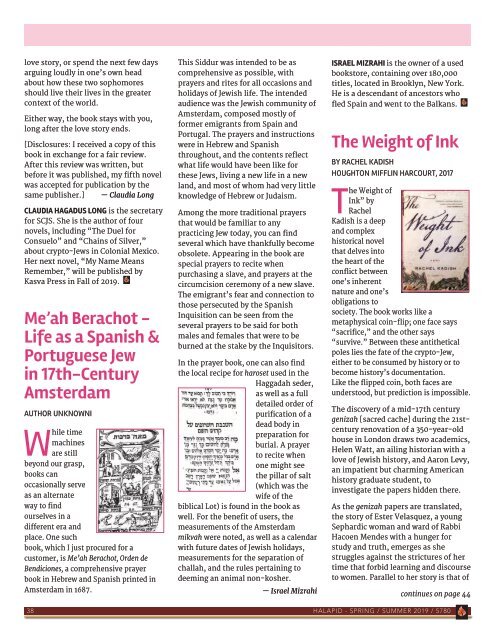HaLapid-Spring Summer 2019
Create successful ePaper yourself
Turn your PDF publications into a flip-book with our unique Google optimized e-Paper software.
love story, or spend the next few days<br />
arguing loudly in one’s own head<br />
about how these two sophomores<br />
should live their lives in the greater<br />
context of the world.<br />
Either way, the book stays with you,<br />
long after the love story ends.<br />
[Disclosures: I received a copy of this<br />
book in exchange for a fair review.<br />
After this review was written, but<br />
before it was published, my fifth novel<br />
was accepted for publication by the<br />
same publisher.] — Claudia Long<br />
Claudia Hagadus Long is the secretary<br />
for SCJS. She is the author of four<br />
novels, including “The Duel for<br />
Consuelo” and “Chains of Silver,”<br />
about crypto-Jews in Colonial Mexico.<br />
Her next novel, “My Name Means<br />
Remember,” will be published by<br />
Kasva Press in Fall of <strong>2019</strong>.<br />
Me’ah Berachot -<br />
Life as a Spanish &<br />
Portuguese Jew<br />
in 17th-Century<br />
Amsterdam<br />
AUTHOR UNKNOWNi<br />
While time<br />
machines<br />
are still<br />
beyond our grasp,<br />
books can<br />
occasionally serve<br />
as an alternate<br />
way to find<br />
ourselves in a<br />
different era and<br />
place. One such<br />
book, which I just procured for a<br />
customer, is Me’ah Berachot, Orden de<br />
Bendiciones, a comprehensive prayer<br />
book in Hebrew and Spanish printed in<br />
Amsterdam in 1687.<br />
This Siddur was intended to be as<br />
comprehensive as possible, with<br />
prayers and rites for all occasions and<br />
holidays of Jewish life. The intended<br />
audience was the Jewish community of<br />
Amsterdam, composed mostly of<br />
former emigrants from Spain and<br />
Portugal. The prayers and instructions<br />
were in Hebrew and Spanish<br />
throughout, and the contents reflect<br />
what life would have been like for<br />
these Jews, living a new life in a new<br />
land, and most of whom had very little<br />
knowledge of Hebrew or Judaism.<br />
Among the more traditional prayers<br />
that would be familiar to any<br />
practicing Jew today, you can find<br />
several which have thankfully become<br />
obsolete. Appearing in the book are<br />
special prayers to recite when<br />
purchasing a slave, and prayers at the<br />
circumcision ceremony of a new slave.<br />
The emigrant’s fear and connection to<br />
those persecuted by the Spanish<br />
Inquisition can be seen from the<br />
several prayers to be said for both<br />
males and females that were to be<br />
burned at the stake by the Inquisitors.<br />
In the prayer book, one can also find<br />
the local recipe for haroset used in the<br />
Haggadah seder,<br />
as well as a full<br />
detailed order of<br />
purification of a<br />
dead body in<br />
preparation for<br />
burial. A prayer<br />
to recite when<br />
one might see<br />
the pillar of salt<br />
(which was the<br />
wife of the<br />
biblical Lot) is found in the book as<br />
well. For the benefit of users, the<br />
measurements of the Amsterdam<br />
mikvah were noted, as well as a calendar<br />
with future dates of Jewish holidays,<br />
measurements for the separation of<br />
challah, and the rules pertaining to<br />
deeming an animal non-kosher.<br />
— Israel Mizrahi<br />
Israel Mizrahi is the owner of a used<br />
bookstore, containing over 180,000<br />
titles, located in Brooklyn, New York.<br />
He is a descendant of ancestors who<br />
fled Spain and went to the Balkans.<br />
The Weight of Ink<br />
By Rachel Kadish<br />
Houghton Mifflin Harcourt, 2017<br />
The Weight of<br />
Ink” by<br />
Rachel<br />
Kadish is a deep<br />
and complex<br />
historical novel<br />
that delves into<br />
the heart of the<br />
conflict between<br />
one’s inherent<br />
nature and one’s<br />
obligations to<br />
society. The book works like a<br />
metaphysical coin-flip; one face says<br />
“sacrifice,” and the other says<br />
“survive.” Between these antithetical<br />
poles lies the fate of the crypto-Jew,<br />
either to be consumed by history or to<br />
become history’s documentation.<br />
Like the flipped coin, both faces are<br />
understood, but prediction is impossible.<br />
The discovery of a mid-17th century<br />
genizah [sacred cache] during the 21stcentury<br />
renovation of a 350-year-old<br />
house in London draws two academics,<br />
Helen Watt, an ailing historian with a<br />
love of Jewish history, and Aaron Levy,<br />
an impatient but charming American<br />
history graduate student, to<br />
investigate the papers hidden there.<br />
As the genizah papers are translated,<br />
the story of Ester Velasquez, a young<br />
Sephardic woman and ward of Rabbi<br />
Hacoen Mendes with a hunger for<br />
study and truth, emerges as she<br />
struggles against the strictures of her<br />
time that forbid learning and discourse<br />
to women. Parallel to her story is that of<br />
continues on page 44<br />
38 <strong>HaLapid</strong> - SPRING / SUMMER <strong>2019</strong> / 5780



